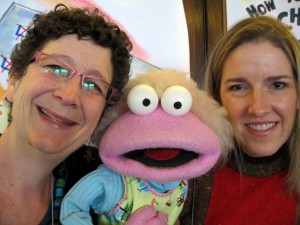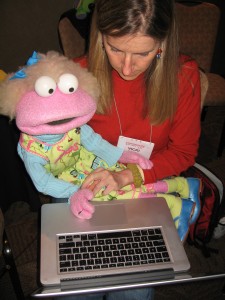Skype 10-Way Video Calling & Some Pink Duct Tape | Synapse3Di. The video speaks for itself – and community technology stewardship. Brava!
Category: online interaction
What Suzie and I Learned (or what a puppet can teach you!)
 You never know what life will bring you. The trick is to say “yes,” and then hold on tight for the ride.
You never know what life will bring you. The trick is to say “yes,” and then hold on tight for the ride.
This post started in October when I was at the CommunityMatters conference. I was running a super short Twitter workshop when Vicki Eibner piped up with a challenge. She herself wasn’t so interested in using Twitter, but there was someone important in her life that might be a match. In fact, this person’s friends were pleading for updates. Suzie. Suzie is pink, with big beautiful eyes and a colorful, ever changing wardrobe. Yes, Suzie is a puppet. (She may disagree, though, so don’t be surprised.)
Suzie, it seems, has a global network that cares about what she’s up to. As a bright pink puppet, age 7 (which is, I learned, 29 in puppet years) people are drawn to her like the proverbial moths to a flame (or me to chocolate!). Suzie’s friends are online and want updates. But Vicki hadn’t crossed that threshold– not so sure she was ready to help. Her question was right in line with the close of the Twitter session – do a small, time delimited experiment with a new tool, debrief it half way and adjust, then at the end, decide what to keep doing and what to chuck out. And most important, have a purpose in mind. I offered to sit down with Vicki and Suzie and think through such an experiment and get Suzie’s account set up. All this was done in three voices, Vicki’s, mine and Suzie’s.I said, let’s do a little peer coaching session and get Suzie signed up. Vicki said, “I’ll go get her out of the car.” And so we began.
 So what do you do when you offer to teach social media to a pink puppet named Suzie? I had no idea, but an hour later, Suzie on her lap, Vicki, Suzie and I began.Suzie and I hit it off right away. A spirit of playfulness, dropping of self consciousness and some balancing of laptops and puppets and away we went.Vicki and I did the initial set up – taking care of account validation, but then we got to the interesting stuff. What does one tweet to the world? What was useful to others, to weaving a network? What was of little value or even inappropriate in the wide open medium of unprotected text?
So what do you do when you offer to teach social media to a pink puppet named Suzie? I had no idea, but an hour later, Suzie on her lap, Vicki, Suzie and I began.Suzie and I hit it off right away. A spirit of playfulness, dropping of self consciousness and some balancing of laptops and puppets and away we went.Vicki and I did the initial set up – taking care of account validation, but then we got to the interesting stuff. What does one tweet to the world? What was useful to others, to weaving a network? What was of little value or even inappropriate in the wide open medium of unprotected text?
Suzie found and added some of the people she knew into her Twitter account. We had so much fun, we actually decided to do a second session and video tape it as a simple introduction to Twitter. I can’t wait until the Orton Foundation folks can get that video up. We watched it and even at a long 15 minutes, it felt pretty fun and flew by. Who’d have “thunkit?”
As always, I walked away with learning as well. When we work for clarity, simplicity and fun, even some of the twisted bits of social media become a little clearer. Ask Suzie, she’ll tell you! Give her a Tweet. She’s been quiet on Twitter, and I think the network can use her energy!
Debrief: the role of visuals in online community management
Today I was a guest of the Community Roundtable, sharing some ideas about the role of visuals in online community facilitation and management. This is the first of two such gatherings this month. The second will be in the context of online learning for the Knowplace event next week. 
We used my free Vyew.com space plus Slideshare.net (since my visual slides created a humongous file size and I was too lazy to break it apart.) I like Vyew’s white board, simple set up and the ability to easy make every participant a collaborator with access to the white board tools.
I offered a bit of context on the general role of visuals in group processes, then some stories about translating those ideas online. After that, the fun really began as we drew together. First I asked them to draw without talking. Then there is a little tool in Vyew where you can make your cursor invisible, so people could not tell WHO was drawing what. I asked them to activate that feature. Then we debriefed. The comments ranged from feeling free to collaborate on an image, to struggling a bit with the tools, to drawing off by oneself in a corner. Some liked the anonymity, some didn’t. Then we talked about how such exercises could be used, particularly in a work context where this might otherwise be seen as frivolous.
Afterwards my hosts, Rachel Happe and Jim Storer were kind to offer (and allow me to share) their feedback. I appreciate that in return for my time in being their guest.
Rachel’s Notes:
I thought it went very well given that most of the people on the call were completely new to the idea of drawing online or together.
The different chairs as an opener gave people a framework/context that they could relate to in order to get started.
I thought the slides plus the playing were a bit hard to fit into an hour but given that I was surprised how active people were – most people seemed to jump right in and unlike the phone, people didn’t have to take turns so everyone – even if they were not collaborating per se – could participate right away which is often really hard to get them to do verbally even if you do call on them and give them time on the call.
Intentionally cutting off talking was also interesting – kind of an odd sensation since I rely so much on getting explicit confirmation from people. Really interesting to watch how collaboration unfolds without voice.
It’s definitely given me some things to think about for our own use.
Jim – other thoughts?
Rachel
Jim’s Notes
Great session! I was trying to observe and participate, which was a bit challenging. I eventually just gave in and participated. Gave me a lot of ideas on how to introduce people to one another. Since using tools like that feels a little silly, it breaks down conventions and barriers pretty quickly. I loved to see how people co-created with each other.
Too much to digest so soon… I wish more members had joined in. They would have enjoyed it.
Thanks again Nancy. I just wished I’d had a chance to tell everyone how I started following you back in 2002 (I think) when I first found your Online Community Toolkit. 🙂
I’ll return with the debrief after the Knowplace event on the 23rd!
Here are the slides:
A Virtual Conversation Overheard
Via the folks at TrainingZone.co.uk I saw a link to this great video. As someone who often challenges people about the false dichotomy of “real” and “virtual” or “online,” this video gave me a good chuckle. But beyond the chuckle, it is a good reminder of the assumptions we carry into both what we design and how we choose to experience in an interaction with others, be it face to face or online.
What assumptions are you carrying?
What does it mean to facilitate an online meeting?
The topic and practice of facilitating online meetings and webinars is cropping up all around my work and play life. People are asking a) when to use online meetings and b) how do to them – WELL! I am in the midst of preparing some resource materials, so I’d like to ask for your favorite resources. And to kick it off, here is a little three minute introduction Chahira Nouira of UN University in Bonn and I made this morning. We had tried Wetoku but the images weren’t so great, so we reverted to Skype and my Flip Camera. Keep it simple!
YouTube – What does it mean to facilitate an online meeting?.
Don’t forget, please share your best online meeting facilitation tips!